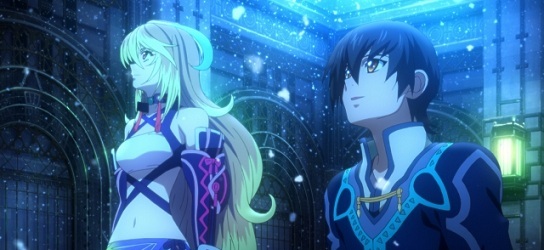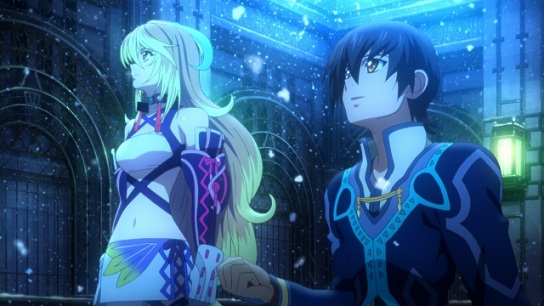
Upon starting Tales of Xillia, players will choose to play primarily as 15-year-old male Jude or 20-something “female” (well, a magical being in the form of a human female), Milla. The decision has a noticeable impact on the way the game’s story is seen, but it’s nothing extreme and definitely can’t be considered two separate stories; it’s more like seeing the same story from one of two perspectives, since Jude and Milla spend the huge majority of the game together. While there are scenes that one character sees and the other does not, Xillia‘s two perspective differences aren’t as extreme as, say, Kingdom Hearts: Birth by Sleep or Suikoden III. As a story-driven game, it succeeds in keeping the player interested, providing ample reason to continue through the plot.
Milla in particular is a strong character, and I hope the localization serves her well. Jude also starts out as a bit of a stereotypical combat-hating Japanese teen protagonist, but eventually gets chances to show his maturity and thought process through story sequences. Hopefully the translation is good to him, too. I feel like the Macho Man portion of society might disregard him unfairly, early on. I suspect those who know Tales, know better.
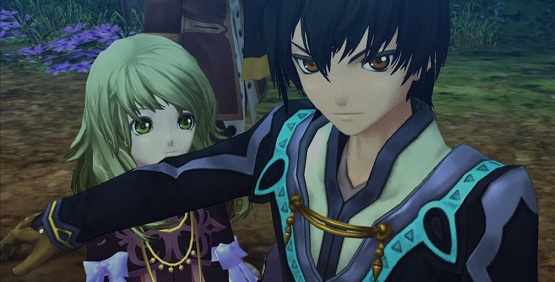
Modern era Tales veterans will feel at home on the battlefields of Xillia. Combat zones are three-dimensional, with the player controlling one character and the others running on modifiable A.I., just the way Tales fans like it. The biggest difference between Xillia and its 3D predecessors (Vesperia, Graces, Symphonia) is the addition of the Battle Link system, which, like its name, allows the player-controlled character to create a sort of tag team with another party member. For example, if you wanna control Milla and then link with Jude, you can count on Jude following Milla almost everywhere around the battlefield; he’ll protect Milla from attacks, try to give her openings to pull off her own moves, and when he gets the chance, he’ll lay a beatdown on the same enemy she’s hitting. Linked party members can perform brutal special moves unique to their duo, as well. It’s a great addition to the battle system, and makes some of the boss battles more strategic affairs than one might have initially anticipated.
Most of the time, ToX is an easy game. If you’ve got a good party set up, you can usually press O to win in non-boss battles. In my playthrough, any time I was in a field, I could comfortably eat with one hand and alternate between X and O with the other, easily earning victory after victory. I wasn’t using many combos because I didn’t need to. True, said combos would speed things up and will therefore remain appealing, but there’s a certain spark missing when combat is this easy. If one wanted to, a player could survive long portions of the game ignoring the skill upgrades or the progress web. When there’s nothing riding on your strategy, it can feel hollow. To its credit, however, several bosses did put up great fights, and those are the ones that matter most.
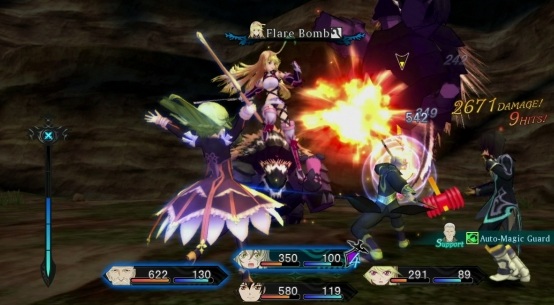
Levels are gained through experience points gained after battle, but these increases don’t come with stat boosts or skill gains of their own. Instead, the player is given a few ability points with which to purchase upgrades from points around a web. All characters’ webs are pretty much the same, though the player can, to some extent, pursue certain strengths in order to build an optimized character. This serves also as a bit of an illusion, as the same node that reads HP +121 for one character will read HP +76 for another. The webs are all built and laid out so that no matter what a player does, each character will handle pretty much exactly the way the designers planned. In that way, the end result is not much different than the RPGs of old, when players were simply given a status update such as:
HP + 15
STR + 3
DEF + 6
AGL + 1
Connor learned Glow In The Dark!
The web is overall a good leveling system, mostly earning props with its style and presentation. It gives a certain measure of control to the player while still bringing characters around to the strengths and weaknesses that the designers had in mind for them all along.
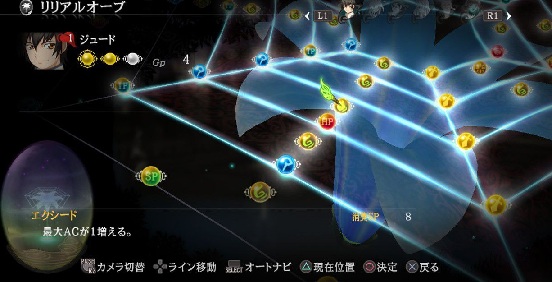
The graphics are certainly strong enough on their own, but the art direction and color palette add to Xillia‘s visual quality. Never does the world look bland or uninteresting. There is a little bit of occasional slowdown when entering battles, and sadly a few cases of visual pop-in as well, but overall, Tales of Xillia is a heck of a pretty game to look at. Fitting Namco Bandai’s love of alternate outfits, players are given piles and piles of accessories to tweak the appearances of their party members. Hint: give everyone the CSI-style sunglasses to add some hilarity to the cut scenes.
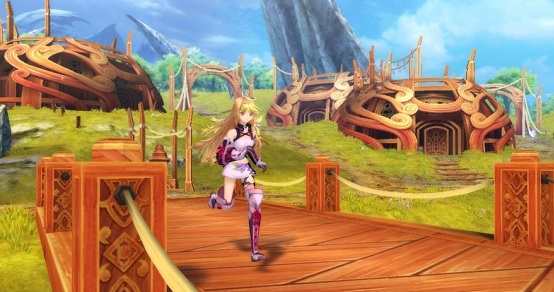
In lieu of an overworld map, Xillia‘s towns are connected by a series of fields not unlike Final Fantasy XII. Dungeons are well designed, and navigating through theses mazes is neither too hard nor too easy. Enemies are visible before fights, and if the player isn’t feeling up to combat, these encounters can easily be evaded. Within these fields lie respawning loot that one can use to improve the quality of shops’ available merchandise. (Arriving in a new town does not mean improved weapons and armor will automatically become available at the stores. You gotta work for it.) It works well to add a certain level of satisfaction to obtaining a new weapon, though some might see it as a layer of tedium.
Tales of Xillia doesn’t set the RPG world on fire, but it’s a memorable adventure that most fans of the genre are likely to enjoy, while those not normally wowed by Japanese RPGs probably won’t find themselves converted. For series fans in particular, this is a game well deserving of attention and funds. Look for it in North America on August 6th.
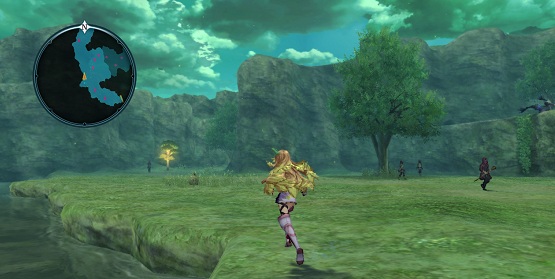
(Post-review notes for importers. Read the PSLS guide to importing here.)
Obviously, this one is so close to English-language release that its import appeal is limited almost exclusively to those studying the Japanese language. If that’s your goal, Tales of Xillia can be a nice practice ground for the things you learn in lessons and study sessions. Since most of the dialogue carries both text and voice, you get the benefit of having your kanji pronunciation suspicions either confirmed or denied, which is nice. There isn’t much furigana, however, so battle tutorials and menus might stump you sometimes. Conversations between characters can be easily understood, as their subject matter and vocabulary stay relatively low, but the more serious plot scenes do get complicated at times. The Japanese version will also lack most of the DLC costumes, some of which are available in the limited edition of the North American version.
-
Environments explorable for the mere sake of exploration.
-
Upgrade web.
-
Milla.
-
All important and semi-important scenes fully voiced, with quality acting to boot (reminder: I played the Japanese version).
-
Classic Tales "skits" are as good as ever.
-
Add +.5 to the score if you're a JRPG fan in general (more than just Final Fantasy).
-
Add another +1 to the score if you're a Tales fan specifically.
-
Xenosyndrome: Very long cut scenes, or otherwise lengthy segments containing only minimal gameplay.
-
A few "kawaii" anime/JRPGisms will bother some.
-
Some hangup/slowdown when entering battle or town.
-
Long stretches of very easy battles, followed by a brute out of nowhere.
